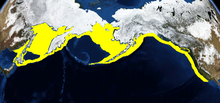Pacific halibut
| Pacific halibut | ||||||||||||
|---|---|---|---|---|---|---|---|---|---|---|---|---|

Pacific halibut ( Hippoglossus stenolepis ) |
||||||||||||
| Systematics | ||||||||||||
|
||||||||||||
| Scientific name | ||||||||||||
| Hippoglossus stenolepis | ||||||||||||
| Schmidt , 1904 |
The Pacific halibut ( Hippoglossus stenolepis ) is the largest flatfish in the northern Pacific . The largest proven length in a female is 2.67 meters with a weight of 363 kg. Males stay smaller. The popular edible fish is usually caught with long lines weighing between 2.3 and 4.5 kg.
features
The dorsal fin begins above the pupil of the lower eye. The dorsal and anal fins are low and only become high in the middle of the body. The caudal fin is wide and slightly moon-shaped, the pectoral fins are small. The eyes are always on the right side of the body. The lateral line organ forms an arch over the pectoral fin. The scales are cycloid and small. The jaws reach the middle of the eyes. The top is usually brown, the blind side white.
Fin formula : dorsal 90–106, anal 69–80
Way of life
The Pacific halibut lives on different soils, at depths from 0 to 1200 meters. Young fish tend to live in shallow water and migrate deeper and deeper as they grow. Older animals spend the winter at greater depths and in summer mainly stay close to the coast at depths of 27 to 274 meters. The Pacific halibut feeds on fish, crabs , clams , cephalopods, and other invertebrates.
literature
- William N. Eschmeyer, Earl S. Herald: A Field Guide to Pacific Coast Fishes of North America. From the Gulf of Alaska to Baja, California. Houghton Mifflin, Boston MA 1983, ISBN 0-395-33188-9 .
Web links
- Pacific halibut on Fishbase.org (English)
